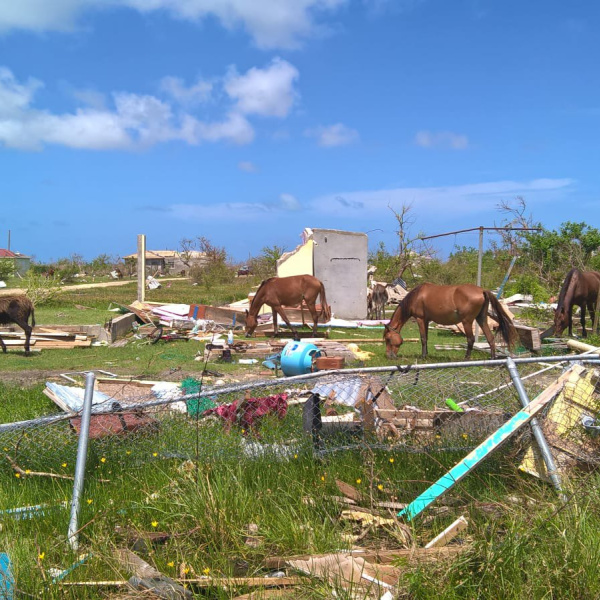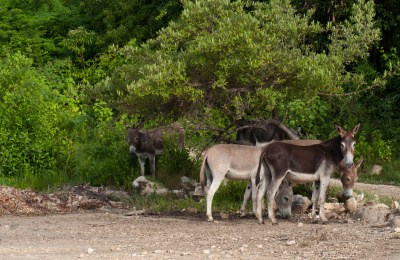In the wake of Hurricane Irma, The Donkey Sanctuary dispatched a team to Barbuda, one of the two major islands that make up the Caribbean nation of Antigua and Barbuda, to ensure the welfare of the island’s feral donkeys, which risk hindering the rebuilding efforts by straying onto the local airport runway.
Simon Pope, Rapid Response and Campaigns Manager at The Donkey Sanctuary and part of that four-man team, describes the devastation first-hand and outlines their efforts to help Barbuda’s donkeys.
“On Monday 2 October, we left our hotel in St John’s, Antigua at 7am, travelling across the island to meet up with Karen Corbin of the Antigua and Barbuda Humane Society as well as World Animal Protection. We loaded our kit, including two dog crates, and headed off towards Barbuda at 8.30 am, hugging the coastline and then heading out into the open waters of the Caribbean. Antigua disappeared from view and we were in open water, sailing across some big waves and dangerous-looking reefs.
After two hours, we saw waves breaking on the low shoreline of Barbuda. As the boat slowed and we came into harbour, we could see that every single building had suffered extensive damage. In some cases the only sign that a building had once existed was the square concrete foundation – everything else had simply been blown away. There were piles of corrugated iron sheets that had blown from the roofs of the small, homely houses, but the most striking thing was the extraordinary force of the hurricane.
Sheets of metal were entwined in the trees, as if some giant hand had tied them round the trunks like a scarf. Every single telegraph pole had either been uprooted entirely, or snapped in half like a matchstick. Imagine the force it takes to break a telegraph pole in two. Cars were overturned, metal cookers lifted from kitchens and hurled out into gardens – everywhere we looked, people’s belongings had been flung far and wide.
And yet only one person was killed from Barbuda’s 1,800 population – nothing short of astonishing given the devastation Hurricane Irma caused. Reeling from the destruction, and with Hurricane Jose gaining strength and bearing down on Barbuda, the island was evacuated.
One of the saddest things I saw was outside a building near the airport: two small holdalls packed with the minimum that a family wanted to take with them. They could have been ordered to leave these behind; if everyone brought bags with them, there would have been no space for everyone. One of the bags was unzipped, probably to retrieve a purse or some jewellery at the last moment, but a child’s toy was lying in the mud beside the bag. There had been no room for it.
While some buildings had simply been blasted into the air, others were standing but heavily damaged. One we passed still had a half-eaten meal sitting on the table, which itself was the only thing that stood on the house foundations.
After loading our kit onto a hurricane-battered 4x4, we set off for the airport. Donkeys and horses had gravitated towards the airport after the evacuation, attracted by the grassy open spaces next to the runway, which in turn meant more wind to keep away the flies that they hate so much. As we expected, the animals were in good condition. Barbuda’s donkeys are wary of people, as it’s true that many of the islanders don’t view them with the same sort of affection that we do.
But while the airport is, for now, a sort of equine haven of their own making, it can’t stay like that. Once the airport returns to action, which won’t happen quickly, having donkeys and horses on the runway is neither good for man nor beast. So in the short-term we’re working on ways to keep them away from the runway, and in the longer term to make sure they don’t feel tempted to wander back.
The next job was to try and get a better picture of just how many donkeys there are in Barbuda. The figure varies from 200 to 2,000, the vagueness of which you might have thought was almost impossible on such a relatively small island. So we began the first half of a census of Barbuda’s donkey population.
The island has large areas of undeveloped scrub-type land, which is the perfect habitat for human-wary donkeys to call home. They don’t bother people and vice versa. There’s plenty of grazing and water, as well as protection from the elements. It’s most likely that with the onset of the hurricane, donkey herds will have huddled close together, laid down and waited for it to pass. Some of the islanders tell of a folklore tradition that the donkeys head for some of the natural caves and take shelter there. The good thing from our point of view was that we saw no injured donkeys.
However, we did see some animals that had succumbed to the power and fury of Irma, such as three donkeys that must have been hit and killed by flying debris, as well as some dogs and a goat.”
The team will continue to assess the situation in Barbuda and report back regularly to the UK – we’ll be posting further updates from the emergency team.

